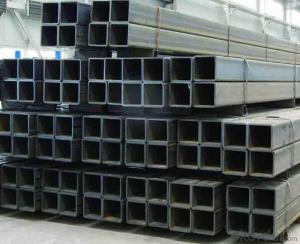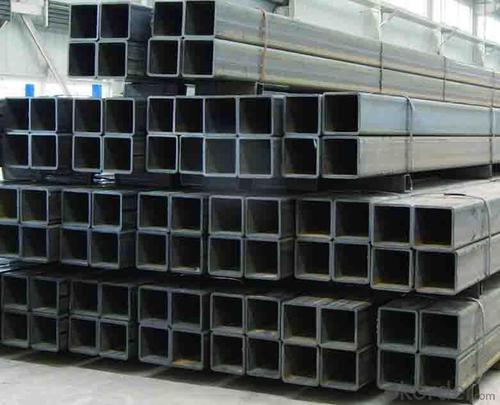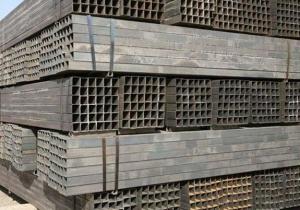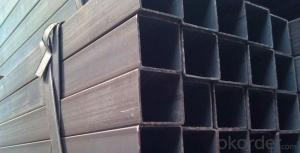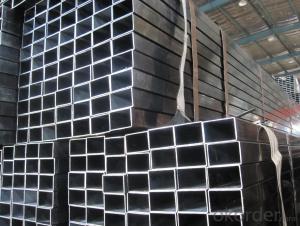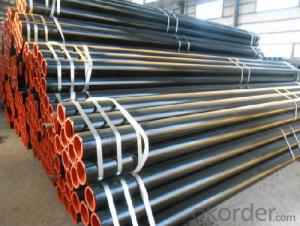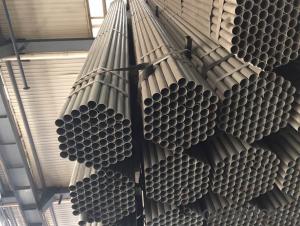ASTM A500/JIS/EN Rectangular hollow section/RHS
- Loading Port:
- Tianjin
- Payment Terms:
- TT OR LC
- Min Order Qty:
- 10 m.t.
- Supply Capability:
- 5000 m.t./month
OKorder Service Pledge
OKorder Financial Service
You Might Also Like
Product Name | rectangular hollow section/ RHS | |
Size | Size: | 10*10--500*500mm |
Thickness: | 0.45--16mm | |
Length: | 3-12m | |
Steel Grade | Q195,Q215,Q235,Q345,16Mn, 20# | |
Standard | ASTM A500,EN10219,GB/T6728,GB/T6725,JIS G3466 | |
Usage | 1. For Structure, Airport, Railway 2. Construction and so on. | |
Ends | Plain end or By Your Choice | |
Surface | Bared Or With Oiled Or Galvanized | |
Technique | ERW ,Hot Rolled and Cold Rolled | |
Section Shape | Rectangular | |
Inspection | With Hydraulic Testing, Eddy Current , Infrared Test | |
Package | Bags, Bundle, In Bulk, Containers | |
MOQ | 20 Metric Ton / Can Be Negotiated | |
Supply Ability | 15,000 Metric Ton/Month | |
Date of Delivery | 7 days(Qty within 1000 Metric Ton) or According To The Quantity | |
Port of Shipment | Tianjin, China | |
Payment | L/C T/T | |
- Q: What are the common uses of stainless steel pipes?
- Various industries widely use stainless steel pipes for numerous purposes. Some common applications of these pipes include: 1. Plumbing and Water Supply: Stainless steel pipes are popularly utilized in residential, commercial, and industrial plumbing systems due to their resistance against corrosion, durability, and capacity to handle high-pressure situations. They are also employed in water treatment plants and wastewater management systems. 2. Oil and Gas Industry: The oil and gas industry extensively relies on stainless steel pipes for the transportation of oil, gas, and other fluids. These pipes can endure high temperatures, pressure, and corrosive environments, making them ideal for this sector. 3. Food and Beverage Industry: The food and beverage industry frequently employs stainless steel pipes because of their hygienic properties and ability to resist corrosion. These pipes are commonly used for the transportation of liquids, gases, and food products in processing plants, breweries, wineries, dairies, and other food-related facilities. 4. Chemical and Petrochemical Industry: Stainless steel pipes play a critical role in the chemical and petrochemical industry, where they are utilized for transporting corrosive chemicals, acids, and other hazardous substances. The pipes' resistance to corrosion and high temperatures makes them suitable for these demanding applications. 5. Construction and Architecture: Stainless steel pipes are utilized in construction and architecture for various purposes such as providing structural support, creating handrails, guardrails, and decorative elements. Their strength, durability, and aesthetic appeal make them a popular choice in contemporary architectural designs. 6. Automotive and Transportation: The automotive industry relies on stainless steel pipes for exhaust systems, fuel lines, and other components that require resistance to high temperatures and corrosion. These pipes are also used in the transportation of fluids and gases in ships, trains, and airplanes. 7. Pharmaceutical Industry: The pharmaceutical industry necessitates high-quality materials that adhere to stringent sanitary standards. Stainless steel pipes are commonly used in pharmaceutical manufacturing processes for transporting liquids, gases, and chemicals due to their cleanability, resistance to corrosion, and compatibility with pharmaceutical products. 8. Power Generation: Stainless steel pipes find applications in power plants, both conventional and renewable, for various purposes such as steam lines, condensers, and heat exchangers. These pipes are selected for their ability to withstand high temperatures, pressure, and corrosive environments. In conclusion, stainless steel pipes have a wide range of applications in various industries, including plumbing, oil and gas, food and beverage, chemical and petrochemical, construction, automotive, pharmaceutical, and power generation. Their resistance to corrosion, durability, and ability to handle high temperatures and pressure make them a versatile and reliable choice for numerous industrial applications.
- Q: What is the difference between internal and external coating for steel pipes?
- Internal coating for steel pipes refers to the application of a protective layer on the inner surface of the pipe to prevent corrosion and increase durability. This coating is designed to withstand the flow of fluids or gases through the pipe, ensuring the integrity of the material and minimizing the risk of contamination. On the other hand, external coating for steel pipes involves applying a protective layer on the outer surface of the pipe to safeguard it from environmental factors such as moisture, chemicals, or mechanical damage. This coating acts as a barrier, shielding the pipe from corrosion and extending its lifespan. In summary, internal coating focuses on protecting the inner surface of the steel pipe, while external coating aims to safeguard the outer surface. Both coatings are crucial for ensuring the longevity and reliability of steel pipes in various applications.
- Q: How are steel pipes protected against mechanical damage during transportation?
- Various measures are implemented to safeguard steel pipes against mechanical damage during transportation. One commonly used technique involves the application of protective coatings or wrapping materials, typically composed of plastic, rubber, or epoxy. These coatings serve as a physical barrier, shielding the pipes from scratches, dents, and other forms of mechanical harm. Another method involves the utilization of padding or cushioning materials, such as foam inserts or rubber gaskets. These materials are inserted inside or wrapped around the pipes, absorbing any impacts or shocks that may occur during transportation. This effectively prevents potential damage caused by vibrations or bumps. Additionally, steel pipes are frequently secured and immobilized within transportation containers through the use of straps, braces, or other securing devices. These measures ensure that the pipes remain stable and do not collide with one another, thereby minimizing the risk of mechanical harm. Furthermore, proper handling and loading techniques play a crucial role in protecting steel pipes during transportation. This involves the utilization of appropriate lifting equipment, such as cranes or forklifts, to prevent any accidental dropping or mishandling of the pipes. Moreover, pipes are often stored or stacked in a manner that minimizes the possibility of deformation or bending. Ultimately, a combination of protective coatings, cushioning materials, securement devices, and proper handling techniques are employed to ensure the safe transportation of steel pipes and maintain their optimal condition for use in various applications.
- Q: How are steel pipes used in the construction of stormwater drainage systems?
- Steel pipes are commonly used in the construction of stormwater drainage systems due to their durability and strength. They are used to create underground networks that efficiently channel rainwater away from urban areas, preventing floods and water damage. Steel pipes are resistant to corrosion and can withstand heavy loads, making them suitable for the long-term and reliable functioning of stormwater drainage systems.
- Q: What are the lengths of scaffold steel tubes?
- Scaffolding steel pipe standard length is 6 meters, for easy use, respectively, 6 meters, 3 meters, 2 meters, 1.5 meters, 1 meters, etc., if there is a special length, you need to intercept.
- Q: How many meters per ton of steel tube?
- General scaffolding tube diameter 40mm, specifications specify wall thickness of 3.5mm, the actual wall thickness of 3.2 - 3.4mm.The theoretical weight per meter is 3.85kg and the wall thickness is 3mm.Hence a ton of steel is about 260m.
- Q: What are the specifications for steel pipes used in high-pressure applications?
- The specifications for steel pipes used in high-pressure applications typically include factors such as material composition, wall thickness, diameter, and pressure rating. These pipes are often made from strong and durable steel alloys, such as carbon steel or stainless steel, to ensure their ability to withstand high pressures. The wall thickness and diameter of the pipe are carefully selected to handle the specific pressure requirements of the application. Additionally, the pipes may need to meet certain industry standards, such as ASTM or ASME codes, to ensure their quality and performance in high-pressure environments.
- Q: What are the different coatings applied to steel pipes?
- There are several different coatings that can be applied to steel pipes to enhance their corrosion resistance and durability. Some common coatings include epoxy coatings, polyethylene coatings, zinc coatings (galvanization), and polyurethane coatings. Each coating has its own specific benefits and is chosen based on the intended application and environmental conditions.
- Q: Can steel pipes handle extreme weather conditions?
- Yes, steel pipes are known for their durability and ability to withstand extreme weather conditions. They are resistant to corrosion, rust, and can handle high temperatures, making them suitable for various climate conditions.
- Q: How are steel pipes used in the manufacturing of shipbuilding?
- Steel pipes are widely used in shipbuilding for various purposes such as the transportation of fluids, gases, and air systems, as well as structural applications. They are commonly used for the construction of ship hulls, bulkheads, and decks, providing strength and durability to withstand the harsh marine environment. Steel pipes are also used in the installation of various systems onboard, including fuel, water, and sewage systems, as well as ventilation and firefighting systems. Overall, steel pipes play a vital role in the construction and operation of ships, ensuring their functionality and safety.
Send your message to us
ASTM A500/JIS/EN Rectangular hollow section/RHS
- Loading Port:
- Tianjin
- Payment Terms:
- TT OR LC
- Min Order Qty:
- 10 m.t.
- Supply Capability:
- 5000 m.t./month
OKorder Service Pledge
OKorder Financial Service
Similar products
Hot products
Hot Searches
Related keywords
